|
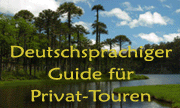
|
| “Los
Nevados” Trail – Villarrica National Park
|
|
Leider
hatten wir bisher noch nicht Gelegenheit, diese Seite ins
Deutsche zu übersetzen. Bei eventuellen Fragen können
Sie sich aber an uns wenden. |
| |
This
excursion goes around the east slopes of the Villarrica volcano
through a high volcanic desert which, sometimes, looks like
a moon landscape. It is possible to observe several ancient
secondary craters and there is also a good view towards the
Quetrupillán, Lanín and Llaima, but is seldom
possible to see the top of the Villarrica.
You can combine this excursion with the trail “Challupén
– Chinay” to go almost all the way around the Villarrica
for three days, or –doing the trail the other way round-
start here the traverse towards the Laguna Los Patos and Puesco |
|
 |
| General
Information: |
| |
Distance
and duration:
There are 12 kms, 3½-5 hours, from the parking place
at the Chinay pass until the end of the trail in the limit
of the National Park. From this place there are 4 kms more
downhill through a local road until the fork next to the Chapel
Los Nevados, where you will have more chances to find a car
for hitchhiking. Or there are 8.5 kms in all until the main
road Pucón – Curarrehue.
The
starting point is at 1.290 m, the highest point (Portezuelo
Cerro Colorado) is at 1.555 m, and the total ascent are 560
m.
If the car only can go as far as the CONAF rangers’
office in Chinay, you must add other 4 kms and 1 to 1½
hours.
If you want to take the detour towards the glacier Pichillancahue
there are 5.6 kms (310 meters of total ascent) and 1½-2
extra hours
Physical
demand:
Moderate; it is high if you have to walk from the rangers’
office to the road to Pucón. There are long legs without
water.
Orientation:
Difficult;
even though the trail is marked with iron stakes, there are
parts where they are missing because they were washed away
by mudslides. From the summer pasture lands of Los Nevados
it is possible that some cows enter into the National Park,
and its prints can be clearer than the real trail. Only for
people with experience in orientation, and if you are not
sure, it is better to hire a guide. Use of GPS is recommended.
Best
time to do it:
January to May.
Equipment:
Good trekking shoes are a must, and hiking poles are also
recommended. Take water.
Entrance
fee:
Tickets must be bought before at www.pasesparques.cl and shown at the CONAF
ranger station. |
|
 |
| How
to get there: |
Getting
out of Pucón take the paved road to Argentina (Camino
Internacional) until the crossing Palguín (km 20),
turn to the south and keep on driving to the Hot Springs of
Palguín through a good gravel road. Instead of entering
to the hot springs (km 30) take the road to the left with
the sign “Coñaripe”. At km 35 there is
a gate that welcomes you to the National Park and the road
gets worse. This area is known as “Chinay”. A
little bit ahead there is the CONAF’s office (km 36)
where they charge the entrance fee and you can ask about the
conditions of the rest of the road. From here on four-wheel-drive
is a must. First there is a part full with roots and large
rocks, and then it comes the final ascent to the pass. Farther
ahead there is a parking place with the beginning of the trail.
There are 40 kilometers from Pucón, but due to the
poor state of the road it takes 1½ hours. Until the
rangers’ office there are 36 kilometers, approximately
an hour. |
| |
 |
| Route
description: |
The
first part goes along the trail marked “Pichillancahue”.
There is a soft ascent through a spectacular araucaria forest
mixed first with coigües and then with lengas, but after
20 minutes walking we already reach the limit of the forest.
Here we have a wonderful view in 360º to the volcanoes
Villarrica to the west, Llaima and Sollipulli to the north,
Quetrupillán and Lanín to the east and Choshuenco/Mocho
to the south. Soon afterwards there is a fork to the right
where officially starts the CONAF’s trail “Los
Nevados”, meanwhile the trail to the glacier Pichillancahue
continues straight ahead. This detour takes 5.6 kms round
way, 310 m of total ascent and 1½-2 extra hours.
If you take the trail Los Nevados, you will see that from
now on the road is marked with stakes painted in pink, we
continue through high pasture lands until reaching in 5 minutes
a brook with crystal clear waters. It is the first of only
three places where you can get water along the road. There
is a bizarre rock formation nearby, with basalt columns in
its classical hexagonal form. After that starts a soft ascent,
and then the path continues over the limit of the forest,
crosses a second brook at stake number 5 until it enters into
a small forest of stubby lengas about 50 minutes after the
bifurcation. The shadow protects us only for few meters, but
5 minutes later the path enters again into a forest, bigger
this time and with taller trees. Among the vegetation there
are cow prints that usually come to this height, and you must
be very careful not to loose the right trail that –after
about 250 meters inside the forest- turns to the left and
starts to get downhill towards the bottom of the valley. Ten
minutes later we should be getting at stake number 8 next
to a river, a good place for a picnic or to pitch a tent if
necessary. This is the last chance to take water for the next
three hours, until reaching the vehicular road.
Past the river, the trail gets uphill along the valley, gets
to a plateau and turns northeast. At the bottom you can see
a pass that separates the walls of the Villarrica from the
Cerro Colorado which lies to our north. This pass, which we
reach after walking for 30 to 45 minutes from the river, is
the highest point of the trail Los Nevados. From here it takes
a general direction between north and northeast. Now starts
another part with difficult orientation. Sometimes the path
is barely visible, sometimes in divides in two with no clear
reason. The stakes help, but there are some missing. In general,
the trail gets downhill, with short parts uphill to get out
of the several dry creeks that go to the east, which were
formed by the winter rains. The road continues along the left
side of a small hill called by the locals “Cerro Bayo”,
for its clear brown color. Then it goes around the Cerro Negro
to the right. The landscape has turned moonlike, almost with
no vegetation. Finally we recognize an extinguished crater,
still over the limit of the forest, but covered with Andean
grass. This is the Cerro Sillón, which left’s
slopes come 60 to 75 minutes after the pass.
At stake 25 the trail gets to another dry creek and continues
along it until getting into a forest and later you have to
get to the bottom of the creek. On the rocky and sandy river
bed araucarias grow, which due to the mudslides are buried
in several meters of sediments, so only the tops are visible.
The trail continues trough a dry river bed until entering
a thicker forest. Finally we get to a T shaped crossing with
an ancient timber road: here is the limit of the National
Park. Both arms of the road meet ahead; the one to the right
is slightly shorter. Ten minutes later we get to a fence.
Until this place you could hire a car to pick you up.
If you have to continue on foot, you must take the local road.
This area is populated by people that live from livestock
and timber work. 10 minutes later is the fork to the left
to get to the “Mountain Lodge”, a private shelter
which is often closed. After walking for another 15 minutes,
the road crosses a small channel that was built 50 years ago,
and which provides with water to all the area of Los Nevados,
since the soil is so porous that there are no brooks. 10 minutes
afterwards there is a gate normally locked, if you are coming
from the other side with a car and wish to drive through,
you must ask for permission at a house about 400 metros before,
at the right coming from the road. There are 20 minutes more
to the rural Chapel of Los Nevados where there is a crossing
and also more chances to find a ride. One more hour downhill
is the main road Pucón-Curarrehue, with public transportation.
|
 |
| Logistische
Unterstützung: |
GPS Miete:
Wir können Ihnen einen GPS-Empfänger Garmin eTrex
mit den für diese Wanderung nötigen Tracks und Waypoints
vermieten.
Für nähere Informationen >  |
| |
|
|
|
Click
here
to see enlarged images

Area map
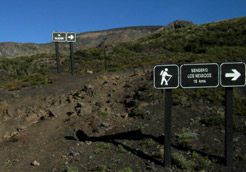
Splitting point of the trails "Pichillancahue" and "Los
Nevados"
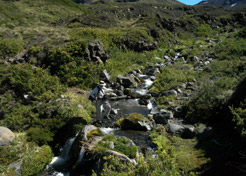
One of the few creeks to get water
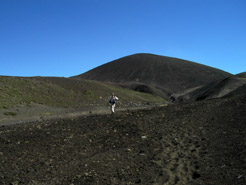
Large streches wich volcnic ashes
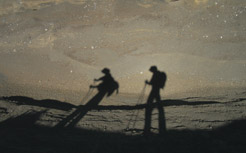
Hikers in a moonlike landscape

Meeting the vegetation again
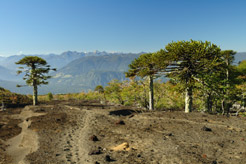
Araucaria trees half-burried in sediments
|









